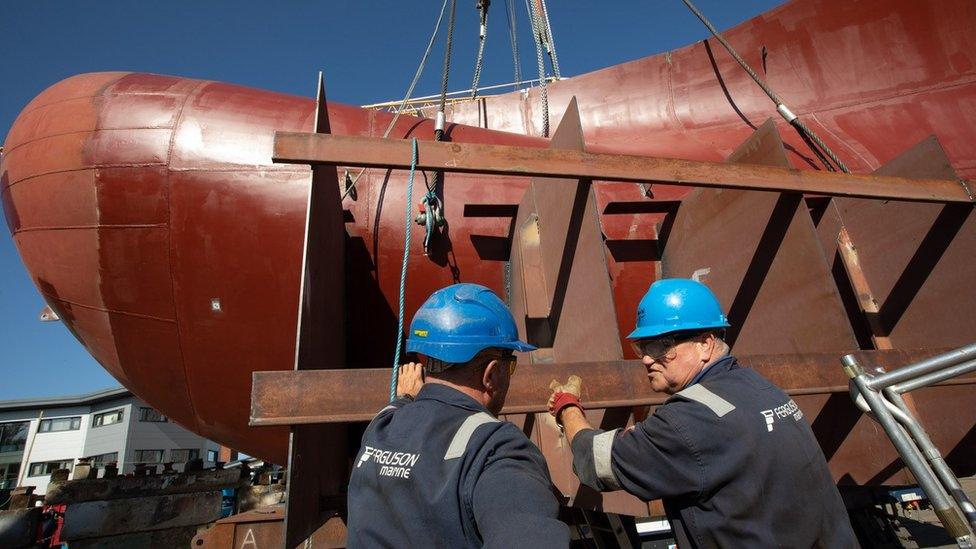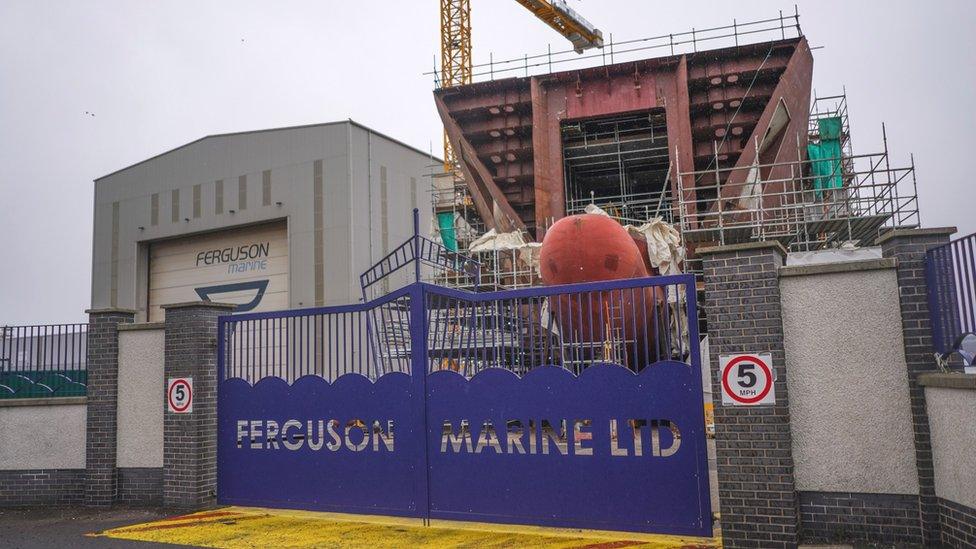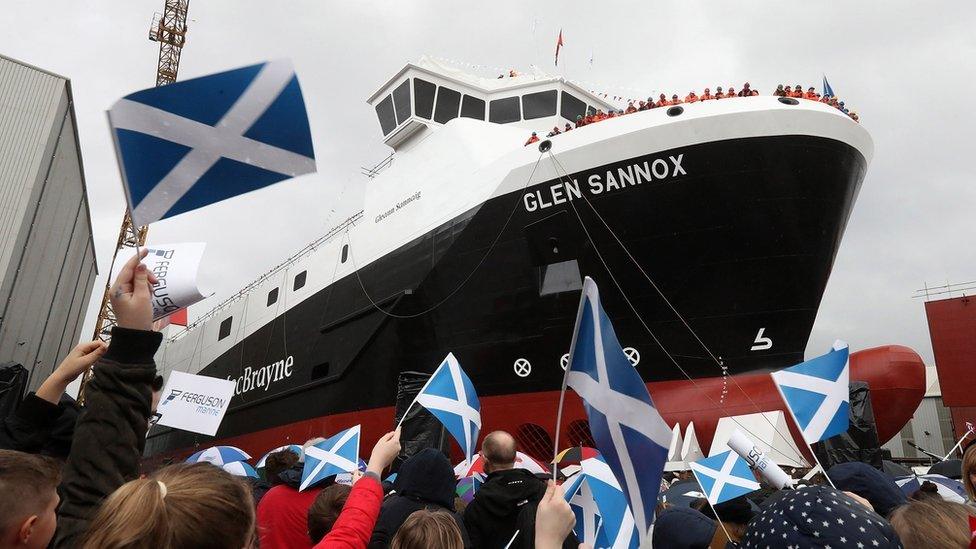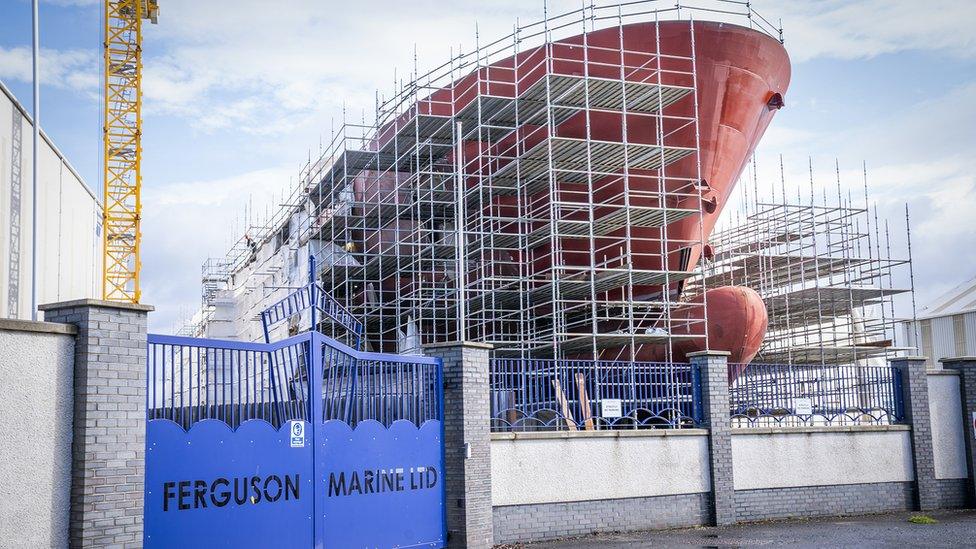Future of ferry fiasco shipyard in deeper doubt
- Published

The bulbous bow being lifted into place on Hull 802 at the Ferguson shipyard in Port Glasgow
The Ferguson ferry fiasco has entered a new phase, where doubts of Scottish government financial support make it impossible to bid for more work.
Accounts have just been published which cast doubt on the ability of the shipyard to remain solvent through this year.
Scottish ministers could bankroll the yard, but they're under pressure from their financial watchdog to put a cap on the costs of such loss-making ventures.
Twenty years ago, heading into the second Scottish Parliament election, the First Minister, Jack McConnell, sensed that one issue had become a lightning rod for raw public anger about the disappointments of the early years.
To clear political space so that he could fight the campaign, the Scottish Labour leader had to start with a promise that there would be a full, public inquiry into the building of the new parliament at Holyrood.
The upturned boats were massively over-budget. We had been told it could cost as little as £40m, not including lots of elements we weren't told about. By 2003, the bill was running to £440m or so.
The inquiry, under Queen's Counsel and Tory politician Lord Fraser of Carmyllie, concluded that the Holyrood building contract suffered from several flaws.
One was that the building had begun long before the design was complete.
And as the spec kept changing, due to the shifting demands of the client, redesign and retrofitting the desired alterations added massively to the cost. It also suffered from a confusion over who the client was.
Design changes

Glen Sannox will now not be ready until the autumn rather than May of this year.
You might hope that the lessons would be applied to subsequent major government procurement projects.
The building of two CalMac ferries at the Ferguson shipyard in Port Glasgow may not have seemed that major. But it's become major, for the wrong reasons, and the project shows remarkable similarities to Holyrood.
There are at least four clients: The Scottish government, Transport Scotland (sidelined), the lead one has been Caledonian Maritime Asset Limited (CMAL, the Scottish government's ferry and pier procurement agency) and CalMac, the end user along with its passengers and freight customers.
Building went ahead long before the design was complete, on ships that were far from straightforward. They had the challenge of dual fuel - both diesel and liquified natural gas. The first hull was launched, apparently to a political timetable, long before it was optimal to do so, adding considerably to the cost.
CMAL is accused by the former shipyard owner of making endless changes to the design, long after the ships were begun and even after Hull 801 was launched.
According to the latest assessment by Audit Scotland, it seems the design stage is still going on.
At least, we are told, saving this shipbuilding project protected jobs on the Clyde.
Open chequebook

Ferguson shipyard has struggled to find the workers it needs
Well, that's not so clear from the accounts of Ferguson Marine Port Glasgow (Holdings) Limited. These have just been published on the Companies House website, covering the financial year 2021-22.
They show that, rather than saving jobs, the shipyard has struggled to find the workers it needs, failing to compete with other engineering employers on pay, and relying on agencies to recruit overseas.
You may recall that the failure to publish these accounts to deadline caused Companies House to warn that it might force the shipyard to stop trading. That execution was stayed after explanation from the chief executive that "auditors Grant Thornton [were] closing some outstanding issues with Audit Scotland and the Scottish government".
What important issues? They didn't say then, but the suspicion was that the government and its financial watchdog were not willing to continue the open chequebook approach to this unhappy saga.
That suspicion is supported by the accounts we can now read. Directors of the company have to admit, with their auditors' support, that they cannot confidently say that Ferguson is on course to remain solvent for the next 12 months.
There is "material uncertainty" that cast "significant doubt on the company's ability to continue as a going concern".
That is the big red flag that no company wants to plant on its accounts. Every shareholder should shudder. And the only shareholder, in this case, is known as the legally entity "Scottish ministers".
Letter of comfort

Glen Sannox was launched in November 2017 - complete with "windows" that had been painted on
The previous accounts, for 2020-21 said the Scottish government would continue to keep the shipyard financially afloat while monthly payments were made towards the two unfinished ferries.
The better news in the more recent accounts is that they anticipate these ferries being completed. But of course, it's not that simple. The Scottish government is checking the continued rising costs to complete the ships, Glen Sannox and Hull 802.
That, alongside "wider due diligence, creates uncertainty over Scottish ministers' future commitment to fully fund the two vessels through to completion".
There's a separate subsidiary, representing the yard and its future orders, which faces similar uncertainty.
"There is not yet clarity over the future investment by Scottish ministers, beyond Hulls 801 and 802, which would allow additional investment in the yard, enabling the yard to competitively compete for and win new work".
In late December, there was a "letter of comfort" issued by the Scottish government about its commitment of further funding. But it wasn't that comfortable. Grant Thornton reported to Audit Scotland: "the letter contains several caveats on the assurance provided on ensuring value for money".
Last orders?

Nicola Sturgeon joined Jim McColl in August 2015 when she announced the yard was the preferred bidder
Once the ferries are finished - if they are finished - income dries up. There are no other contracts on the books. Without more income, the shipyard is conceding that it won't be able to meet its liabilities.
There are hopes of winning smaller ferry contracts for Cal-Mac and hopes of winning parcels of work for Royal Navy frigates being assembled by BAE Systems.
Grant Thornton, reminds us that "to date, any contract work bid for Ferguson Marine Port Glasgow have been unsuccessful".
For now, there is a trickle of funds for 18 workers seconded to BAE Systems.
But without further investment backed by taxpayer funds, it's unlikely the yard can bid for future contracts.
And if it did, you may recall from Jim McColl's ownership of the yard, it would have to provide secure and probably very expensive financial guarantees that it would finish the work. Such financial instruments are priced on risk, and this yard looks risky. Would you trust it to build your ship, ferry or superyacht?
Ministers could help if they simply bankrolled the shipyard further, and made their letter of comfort more comfortable.
But they have come under pressure from their watchdog, Audit Scotland, flagging up concerns that Holyrood ministers seem to have developed an unchecked habit for adopting loss-making enterprises: A shipyard, steel, aluminium, fabrication yards and an airport.
Islander ire

Glen Sannox and hull 802 are still being constructed at Ferguson shipyard
To recap, there is the exorbitant cost of the ferries - now more than three times the original £97m contract, and still rising. The Scottish government found a further £21m in the financial year now ending.
Audit Scotland reported around £9.5m for which no budget has been found. The accounts say that the costs, at sign-off this year, were £12m ahead of the available budget. And equipment inflation is expected to keep at least the cost of Hull 802 rising.
But that's just one reason for frustration at this project. There is also the impact on Hebridean and Clyde islanders who are left with an ageing, unreliable and under-sized fleet of ferries. They face a tourism season where they don't know if they'll be able to get visitors on or off their islands, and where ferries are rammed, that makes it hard to get space for islanders to travel.
Those twin problems were to the fore as Nicola Sturgeon this week exited the Scottish Parliament as first minister.
With possibly years before they can be resolved, there has to be a real "going concern" risk for the next first minister that this contract becomes a lightning rod for public anger, similar to the one for the Holyrood parliament building.
There is a happier post script.
When the Holyrood building eventually opened, MSPs got to work in it and the public got to see round it, there was a rapid dissipation of that public anger, as Scots adopted their new parliament building.